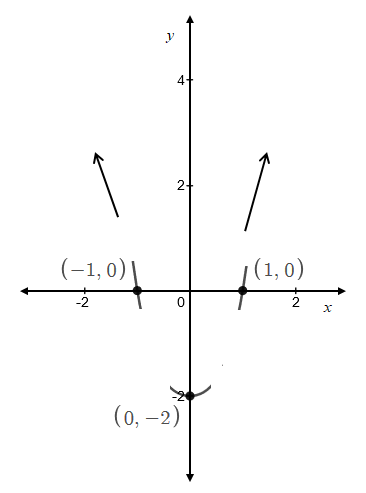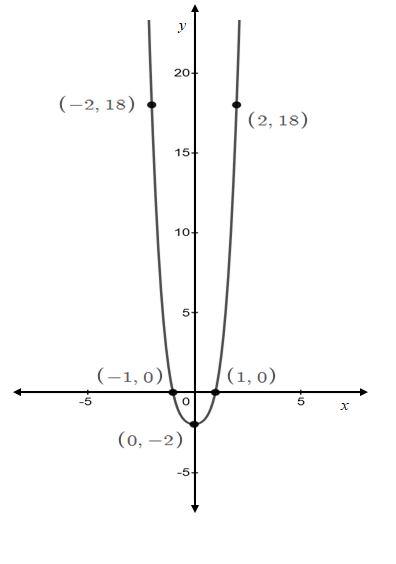
Concept explainers
Mixed Practice In Problems
To graph: The polynomial function
Explanation of Solution
Given Information:
The polynomial function
Graph:
The steps of graphing the polynomial function as follows:
Step 1: First, find the end behavior of the graph of the function
Here, the degree of the polynomial function
The graph of the function
Step 2: Find
For the
Thus, the
For the
Since there is 1 variation in the sign of the non-zero coefficients of
There is 1 variation in the sign of the non-zero coefficients of
By using the Rational Zero Theorem, all possible rational zeroes are of the form
In the polynomial
Factors of the constant term
Factors of the leading term
Therefore, all the possible rational zeros are:
Simplifies to,
As there is 1 or 0 positive and 1 or 0 negative real zero, all potential rational zeros of the polynomial function
Now, test
Here, since the remainder is 0,
To write the factors of
Here,
Any solution to this depressed equation is also a zero of
The depressed equation
Thus, the real zeros of the polynomial function
Step 3: The maximum number of turning points on the graph of the function
The polynomial function
Step 4: Now, use the information obtained in step 1 to 3 to draw the graph of the function

Now, find additional points on the graph.
For
For
Now, plot all these coordinates
So, the graph of the function is as follows:

Interpretation:
The graph represents the polynomial function
Chapter 4 Solutions
Precalculus
Additional Math Textbook Solutions
Elementary Statistics: Picturing the World (7th Edition)
Pre-Algebra Student Edition
Elementary Statistics
A First Course in Probability (10th Edition)
Elementary Statistics (13th Edition)
Calculus: Early Transcendentals (2nd Edition)
- Pls help ASAParrow_forward3. True False. If false create functions that prove it is false. Note: f(x) = g(x). a) If_lim ƒ(x) = ∞ and_lim g(x) = ∞,then_lim [ƒ(x) − g(x)] = 0 x→ 0+ x→0+ x→0+ b) If h(x) and g(x) are continuous at x = c, and if h(c) > 0 and g(c) = 0, then h(x) lim. will = x→c g(x) c) If lim f(x) = 0 and lim g(x) = 0 then lim f(x) does not exist. x-a x-a x→a g(x)arrow_forwardPls help ASAParrow_forward
- 15. a) Consider f(x) = x-1 3x+2 and use the difference quotient to determine the simplified expression in terms of x, for the slope of any tangent to y = f(x). Also, determine the slope at x = 2. 15 b) Determine the equation of the tangent to f(x) at x = 2. Final answer in Standard Form Ax + By + C = 0, A ≥ 0, with no fractions or decimals.arrow_forwardPls help ASAParrow_forwardPls help ASAParrow_forward
- Determine whether the series is convergent or divergent. Justify your answer. If the series is convergent, you do not have to find its sum. n=0 (-1) 72n+1 (2n)!arrow_forward+ Find the first five non-zero terms of the Taylor series for f(x) = sin(2x) centered at 4π. + + + ...arrow_forward+ + ... Find the first five non-zero terms of the Taylor series for f(x) centered at x = 4. = 1 x + + +arrow_forward
 Calculus: Early TranscendentalsCalculusISBN:9781285741550Author:James StewartPublisher:Cengage Learning
Calculus: Early TranscendentalsCalculusISBN:9781285741550Author:James StewartPublisher:Cengage Learning Thomas' Calculus (14th Edition)CalculusISBN:9780134438986Author:Joel R. Hass, Christopher E. Heil, Maurice D. WeirPublisher:PEARSON
Thomas' Calculus (14th Edition)CalculusISBN:9780134438986Author:Joel R. Hass, Christopher E. Heil, Maurice D. WeirPublisher:PEARSON Calculus: Early Transcendentals (3rd Edition)CalculusISBN:9780134763644Author:William L. Briggs, Lyle Cochran, Bernard Gillett, Eric SchulzPublisher:PEARSON
Calculus: Early Transcendentals (3rd Edition)CalculusISBN:9780134763644Author:William L. Briggs, Lyle Cochran, Bernard Gillett, Eric SchulzPublisher:PEARSON Calculus: Early TranscendentalsCalculusISBN:9781319050740Author:Jon Rogawski, Colin Adams, Robert FranzosaPublisher:W. H. Freeman
Calculus: Early TranscendentalsCalculusISBN:9781319050740Author:Jon Rogawski, Colin Adams, Robert FranzosaPublisher:W. H. Freeman
 Calculus: Early Transcendental FunctionsCalculusISBN:9781337552516Author:Ron Larson, Bruce H. EdwardsPublisher:Cengage Learning
Calculus: Early Transcendental FunctionsCalculusISBN:9781337552516Author:Ron Larson, Bruce H. EdwardsPublisher:Cengage Learning





